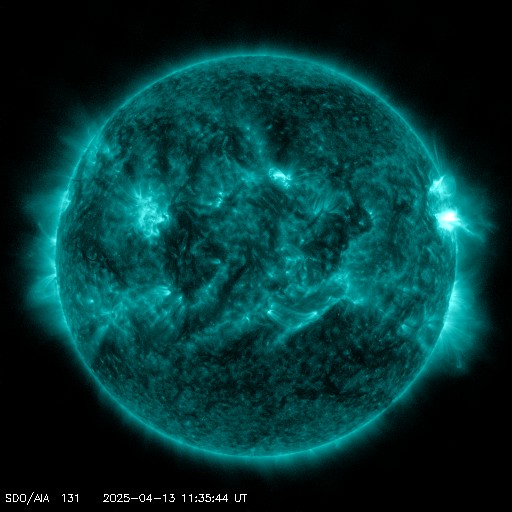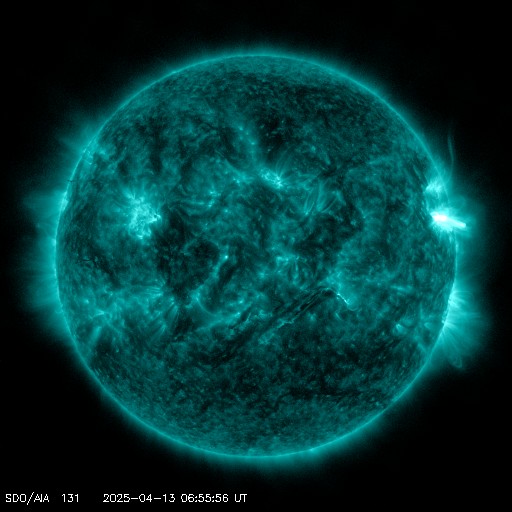Het archief bekijken van zaterdag 13 januari 2024
Dagelijks bulletin over zonne- en geomagnetische activiteit van het SIDC
Datum verslag: 2024 Jan 13 1231 UTC
SIDC Prognose
Zonnevlammen
M-class flares expected (probability >=50%)
Geomagnetisme
Active conditions expected (A>=20 or K=4)
Proton Flux monitor
Quiet
| 10cm flux | Ap | |
|---|---|---|
| 13 Jan 2024 | 180 | 008 |
| 14 Jan 2024 | 182 | 011 |
| 15 Jan 2024 | 182 | 007 |
Zonnevlekkengebieden en zonnevlammen
Solar flaring activity over the past 24 hours was at low levels. The largest flare was a C4.8-flare, with peak time at 17:22 UTC on January 12, associated with NOAA AR 3538 (beyond the west limb). There are currently 12 numbered active regions on the visible disk. Since yesterday, two active regions have rotated away over the west limb, four new active regions have been numbered in the eastern hemisphere, and one new active region has emerged in the south-west quadrant of the solar disk. NOAA AR 3541 (beta-gamma) is the most magnetically complex region on the disk, and together with NOAA AR 3538, NOAA AR 3539 (beta), NOAA AR 3548 (beta), and NOAA AR 3549 (beta), has produced most of the flaring activity in the past 24 hours. The solar flaring activity is likely to be at moderate levels over the coming days with C-class flares expected and M-class flares probable.
Coronale massa uitstoten
Based on currently available coronagraph images, a partial halo coronal mass ejection (CME), with angular width of about 120 degrees and directed towards the south-east, first appeared in SOHO/LASCO coronagraphs around 22:12 UTC on January 12. The plane-of-the-sky speed of the CME was around 700 km/s. The CME was associated with a filament eruption, observed at 22:00 UTC in SDO/AIA 304 near the south-east limb of the solar disk. No clear Earth-directed component has been identified. However, further analysis is on-going.
Coronale gaten
A small mid-latitude coronal hole in the northern hemisphere (with positive magnetic polarity) started crossing the central meridian around 18:00 UTC on January 12. The associated high speed solar wind stream may reach Earth no earlier than January 15.
Zonnewind
Slow solar wind conditions were recorded over the past 24 hours. The solar wind speed as measured by DSCOVR ranged between 470 km/s and 500 km/s, while ACE data was unavailable at this time. The total interplanetary magnetic field fluctuated between 1 nT and 5 nT, with the Bz (north-south) component reaching a minimum value of -3 nT. The phi-angle transitioned from the negative (towards the Sun) to the positive sector (away from the Sun) around 14:53 UTC on January 12, and has remained mainly positive ever since. In the next 24 hours, we expect similar slow solar wind conditions, with a chance of disturbed conditions due to the possible arrival of the coronal mass ejection (CME) first observed on January 09 around 01:25 UTC.
Geomagnetisme
The geomagnetic conditions over the past 24 hours were globally and locally quiet (Kp 2 and K Bel 2). Due to the possible arrival of a coronal mass ejection from January 09, unsettled conditions with short periods of active conditions are possible in the next 24 hours.
Proton flux niveaus
The greater than 10 MeV proton flux is at background level, and is expected to remain at background level in the past 24 hours. Due to the number of complex regions currently on the disk, however, we cannot exclude the possibility of new proton events in the next 24 hours
Elektronenfluxen in geostationaire baan
The greater than 2 MeV GOES 16 electron flux was below the 1000 pfu threshold and is expected to remain so in the next 24 hours. The 24h electron fluence was at nominal level and is expected to remain so in the next 24 hours.
Het geschatte internationale zonnevlekkengetal (ISN) van vandaag: 150, gebaseerd op 04 stations.Zon indexen voor 12 Jan 2024
| Wolfgetal Catania | /// |
| 10cm zonneflux | 186 |
| AK Chambon La Forêt | 005 |
| AK Wingst | 003 |
| Geschatte Ap | 002 |
| Geschat internationaal zonnevlekkengetal | 192 - Gebaseerd op 12 stations |
Overzicht opvallende gebeurtenissen
| Dag | Start | Max | Einde | Locatie | Sterkte | OP | 10cm | Catania/NOAA | Soorten radio-uitbarstingen | |
|---|---|---|---|---|---|---|---|---|---|---|
| Geen | ||||||||||
Aangeboden door het Solar Influences Data Analysis Center© - SIDC - Verwerkt door SpaceWeatherLive
Alle tijden in UTC
<< Keer terug naar de dagelijkse overview pagina
Laatste nieuws
Laatste forumberichten
Steun Poollicht.be!
Om ook bereikbaar te blijven bij grote poollichtkansen hebben we een zware server nodig die alle bezoekers aankan. Doneer en steun dit project zodat we online blijven en je geen enkele poollichtkans mist!

Ruimteweer feitjes
| Laatste X-klasse uitbarsting | 28/03/2025 | X1.1 |
| Laatste M-klasse uitbarsting | 13/04/2025 | M1.0 |
| Laatste geomagnetische storm | 06/04/2025 | Kp5 (G1) |
| Zonnevlekkenloze dagen | |
|---|---|
| Laatste zonnevlekkenloze dag | 08/06/2022 |
| Maandelijks gemiddeld zonnevlekkengetal | |
|---|---|
| maart 2025 | 134.2 -20.4 |
| april 2025 | 136.4 +2.2 |
| Afgelopen 30 dagen | 134.7 -7.2 |





